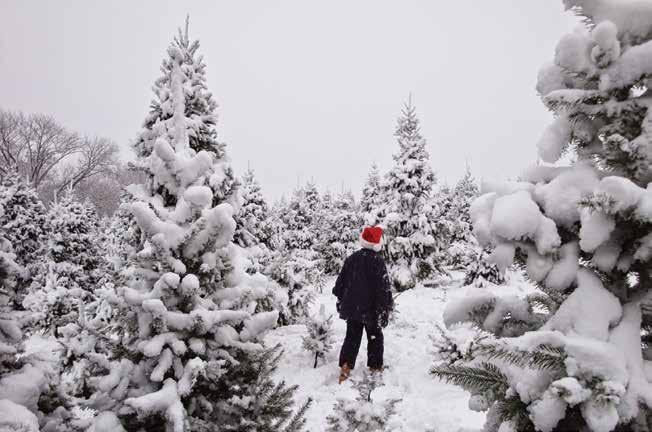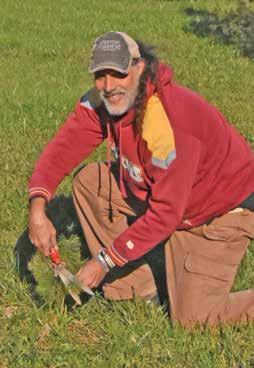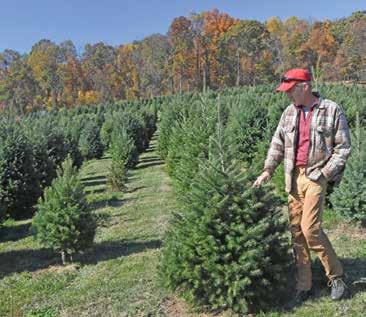
5 minute read
'Tis TANNENBAUM SEASON
'Tis TANNENBAUM SEASON
By John E. Ross

‘Tis Tannenbaum season. Pick your tree: Fraser firs with stiff wellspaced faintly blue-tinged needles; Scots pines with seriously green and bushy boughs; blue spruce with pert but prickly needles; and the southern favorite, white pines so soft and full.
Whatever your tastes, whatever your space, just the right Christmas tree is growing on a tree farm not that far away.
Growing up in Ohio, the right tree around our house had to be a Blue spruce. Branches were spaced just far enough apart so it could be decorated the way Mom wanted. A set of colored lights was strung close to its center so the tree glowed deep from within. Two more strings wrapped the tree just inside its outermost branches.

Ornaments, each imbued with memories of Christmases past, were carefully hung. Mom stood back, directing my brothers and me where to place each and having us move colored bulbs from one light socket to another for just the right effect.
Then came tinsel, one strand at a time, each draped. “Don’t throw it,” I can still hear her instruct. How I hated tinsel.
When we moved to Knoxville in the mid-1950s, our tastes were forced to change. There were no blue spruce. Fraser firs, native to Southern Appalachians, became our tree of choice.
Frasers (Abies fraseri) do not grow well in the Blue Ridge foothills. Yet their nominal but unrelated cousin, Douglas firs (Pseudotsuga menziesii), do very well and are among northern Virginia’s most popular Christmas tree species.
Loudoun Nursery’s Lou Nichols introduced me to concolor fir (Abies concolor) also known as white fir. When young, it grows in a nearly perfectly pyramid shape. Needles are shortish, stout yet soft. Branches easily support ornaments and allow them to hang freely. Break a fresh concolor branch and immediately you’ll smell oranges, just like the ones as kids we loaded with dried cloves to scent the house for the holidays.
Perhaps a bit visionary, Lou’s parents were among the first to grow Christmas trees in this area. Planning to attract customers from Washington’s suburbs, in 1960 they bought a farm on Watson Road just east of US 15 and planted Scots pine, white pine, and some spruces. When Lou returned from Army duty in 1970, the trees were ready for harvest.

A decade later, he bought 175 acres north of Purcellville and opened Loudoun Nursery, continuing the family’s Christmas tree farming tradition. He has 30 acres of various spruces, pines, and firs plus five acres of containergrown trees ready for planting after the holidays.
As Loudoun County’s agricultural development officer, Lou met Ricky Hoybach. In 1998 Ricky needed a home for his landscaping business and bought 47 acres next to Lou’s parents’ old farm. For a cash crop, Ricky planted the same species Lou’s dad had put in the ground and, in 2012, opened Country Loving Christmas Tree Farm.
Easily walked, Country Loving and Loudoun Nursery farms spread across the gently rolling Piedmont. Climbing the eastern flank of the Blue Ridge and readily seen north of Rt. 7 west of Round Hill, Snicker’s Gap Tree Farm contains 42 acres of Douglas firs and Colorado blue spruce.
Here, Steve Wolff’s parents began growing and selling Christmas trees in 1981. An accomplished potter, his mother’s artistic eye is evident everywhere. She’s taught neighbors, and now employees Tony Hernandez and his family, how to sculpt each tree—roughly 35,000 of them—so they’re perfectly grown out and shaped come winter.
Upon arrival at all three tree farms, customers are given pruning saws and directed to plots of their favorite species. Once cut, farm staffs shake trees to remove loose needles and bale them in nets for the trip home. Each farm also sells fresh wreathes, garlands, tree stands, and snacks. Ricky even provides coloring books for kids.
Water is the key to keeping a Christmas tree green. Place the tree in a waterfilled bucket in a garage or other shady place. Add tree food and check every other day. For pre-cut trees, cut three inches off the trunk to remove congealed sap. And do not add sugar to tree water! All it does is clog pores, preventing the tree from drawing water needed to stay green. Inside, place the tree away from heaters and fireplaces. Dress with tinsel if you must.
Country Loving Christmas Tree Farm: Red cedars, firs, pines, spruces –40856 Red Hill Road, Leesburg, VA 20175 –9 a.m. to 4 p.m. Fridays, Saturdays and Sundays through Dec. 17, http://www.countrylovingfarm.com – (703) 929-4749.
Loudoun Nursery: Firs, spruces, container-grown live trees, large trees for churches and community and event centers - 16457 Short Hills Road, Round Hill, VA 20141 – 9 a.m. to 4 p.m. weekends through Dec. 17, http://www.loudounnursery.com – (540) 450-4137.
Snickers Gap Tree Farm: Douglas firs, spruces - 34350 Williams Gap Road Round Hill, VA 20141 – 1 p.m. to 5:30 p.m. weekdays; 9 a.m. to 5:30 p.m. weekends, https://www.snickersgaptrees.com – (540) 554-8323.









